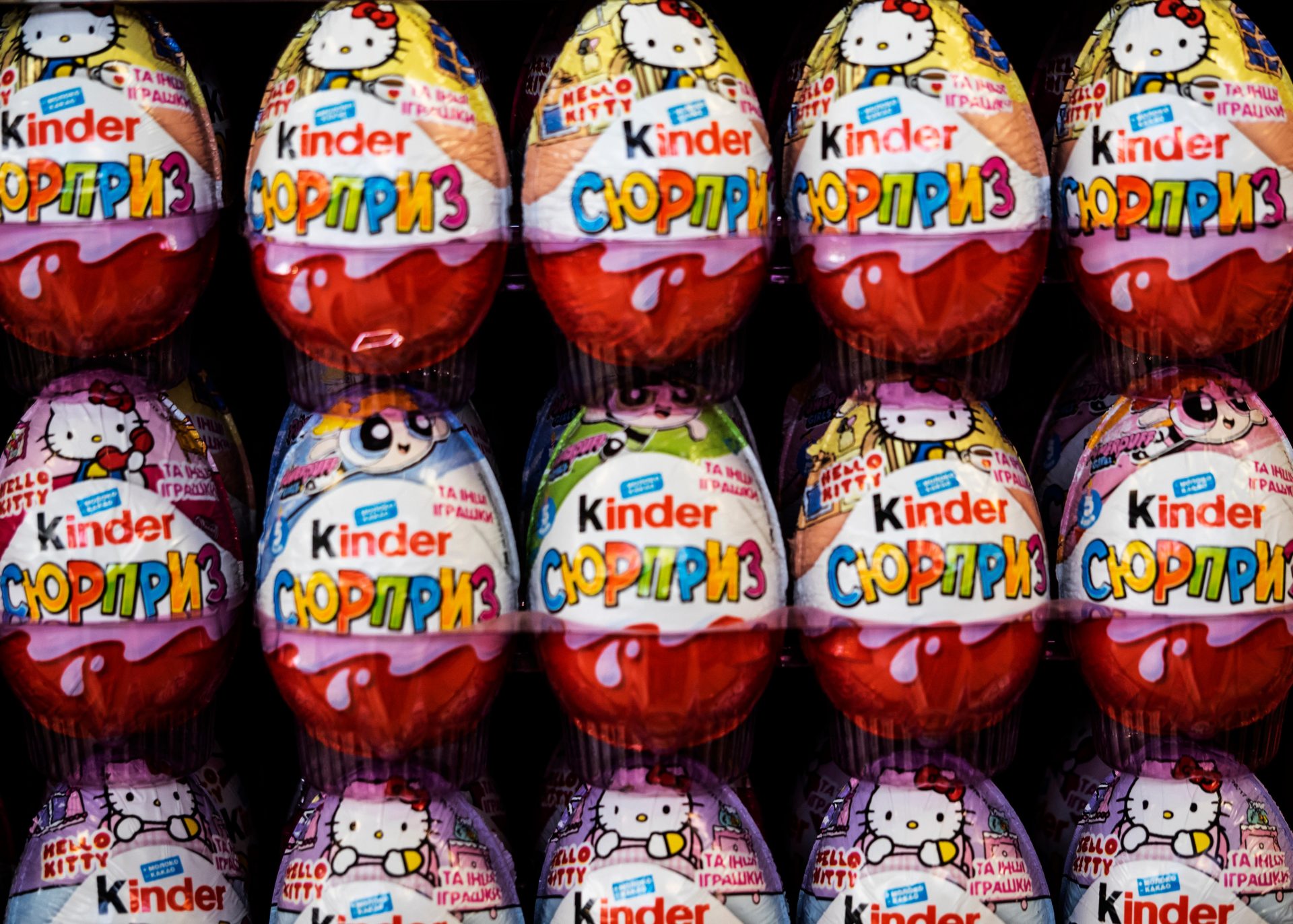The traces of the sweeping changes in post-war European history can be found in even the most apparently minor of details. Such is the case with the Kinder Surprise Egg, whose intricate details are a kind of Rosetta Stone that help us understand the possibilities that an integrating Europe has afforded – but also its limitations.
The eggs are manufactured by the giant corporation Ferrero. Founded in 1946 in Alba, Italy, by the confectioner Pietro Ferrero, it owes its success to Nutella, a spectacularly successful product of straightened post-war circumstances.
In austere post-war Italy, Pietro Ferrero made the scarce commodity of chocolate go further by combining it with the abundant local hazelnuts to make an addictively tasty paste. Now the second largest chocolate producer in the world and still owned by the Ferrero family, it’s headquarters are in Luxembourg, while keeping extensive production facilities in Alba.
Like Nutella, the Kinder Surprise has burst out of Europe to conquer the world. Introduced in the early 1970s, the chocolate egg with a toy inside can be bought across the world. Even the safety concerns about the chocking risks to small children hasn’t slowed this expansion down. In the US, where safety regulations mean the eggs cannot be sold, Ferrero developed the Kinder Joy, a compliant alternative.
It is the original Kinder Surprise Eggs that interest me the most. They contain Ferrero’s creation; a tiny sheet of paper containing 34 warning messages. The English version reads: “WARNING, read and keep: Toy not suitable for children under 3 years. Small parts might be swallowed or inhaled.”
The message is included in lesser known European languages such as Estonian and extends across Eurasia to bring us scripts as unfamiliar as Armenian and Georgian. The message sheet would seem to be a miniscule celebration of linguistic diversity. While I set out to celebrate it in my book The Babel Message: A Love Letter to Language, I also discovered that the warning message sheet also reveals how what we might initially see as the diversity of Europe is, too often, kept within strict limits.
An essential part of the project of European integration has been to give parity to the official languages of constituent states. That isn’t restricted to the EU but extends to the wider European Economic Area. The Kinder Surprise Egg warning sheet includes the distinctive “CE” logo, indicating compliance with the health and safety standards of the European Economic Area.
Part of this involves compliance not only to warning message standards but also to standards for their translation. While an exact form of words is not mandated, the various warning messages in European languages on the sheet “shadow” the suggested wording very closely.
One of the glories of the thriving Kinder Surprise collectors’ subculture is an online collection of warning message sheets, which show how the languages included have expanded over time. You can trace the collapse of the former Yugoslavia on the sheet, as Slovenian, Macedonian, Serbian and Croatian warnings appear in the 1990s and 2000s. The 1990s also saw the appearance of Eastern European languages as their countries’ markets became integrated into the European economy.
Yet this expansion also hides missing languages, blank spots on the Kinder Surprise map of Europe. There is no warning message in Icelandic, Irish or Maltese. The latter two are official EU languages (although a shortage of translators has meant some EU documents are exempt from translation in Irish); they are also languages of countries where English is near-universally spoken. The global dominance of English means that, in product packaging at least, if English is an official language or a lingua franca in a particular country, then the language used often defaults to it.
There are other absences on the warning message sheet too. Until 2014, there were separate Moldovan and Romanian warnings; they are now combined into one, marked RO/ MO. The question of whether Moldovan and Romanian are separate languages is hotly contested but it is surely no coincidence that 2014 coincides with the signing of Moldova’s Association Agreement with the EU.
Then there are the languages that have some kind of official status in European countries but are not treated as such internationally. These include Luxembourgish, Romansch, Catalan and Welsh. When viewed this way, not only does the warning message sheet seem less comprehensive, we are also confronted with the ways in which international recognition of a country’s language may be connected to the marginalisation of other languages in that country.
In The Babel Message I reveal translations of the warning message in many of Europe’s “other” languages. This may sound like a gimmick – and to some extent it is – but the purpose is a serious one. Too often, what we think of as linguistic diversity is much more restricted than it appears. And while unloved texts such as product warning messages may seem to be an unlikely battleground on which to fight for marginalised languages, they are actually more important than they appear. Everyday texts that we don’t even notice we are reading enforce subtle messages about which languages are important and authorised.
European bodies and NGOs have recognised the value of minority languages beyond “official” national ones. The European Charter for Regional and Minority Languages seeks to promote such languages and has been signed by 33 countries. Different countries take such issues more seriously than others.
The state of minority languages such as Occitan in France is parlous, compared with the languages of regions such as Catalonia and Wales.
The real sign of change would be to read the Kinder Surprise warning message in yet more tongues. Perhaps the first addition could be Piedmontese, the language of the region around Alba, home of Ferrero itself:
Les con atension: Ten la dësmora lontan dal masnà con meno ëd tre ann. Ij tòch pì cit a podrìo esse traondù o inalà.
The Babel Message: A Love Letter to Language is published by Icon Books on November 4



